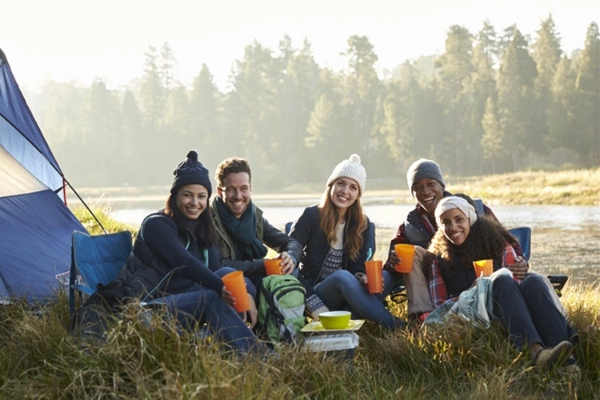Dispersed camping refers to camping outside of designated campgrounds on public lands. Unlike traditional campsites, dispersed camping areas do not offer amenities like restrooms, water, or picnic tables.
Benefits and Drawbacks:
The primary allure of dispersed camping lies in its solitude and the opportunity to immerse oneself in nature. Without the confines of designated campsites, campers can find unique spots far from the crowds, offering a true wilderness experience. However, this freedom comes with challenges. Lack of amenities means you’ll need to be entirely self-sufficient, carrying in all necessary supplies, including water and waste disposal systems. Accessibility can also be an issue, with many dispersed camping areas requiring a high-clearance vehicle or even a hike to reach. Additionally, the environmental impact is a significant concern. Without proper care, dispersed camping can lead to habitat destruction, littering, and other negative effects on the ecosystem.
SEE ALSO: What Do You Need to Go Camping in the Woods
Finding Dispersed Camping Locations
Resources:
Government websites: Agencies like the BLM, U.S. Forest Service, and National Park Service provide maps and information on where dispersed camping is allowed. These sites often include details about regulations, access routes, and any permits that may be required.
Online platforms and apps: Tools like Campendium, iOverlander, and FreeRoam are invaluable for modern campers. These platforms offer user-generated content, including site reviews, GPS coordinates, and photos, making it easier to find the perfect spot.
Guidebooks and maps: For those who prefer traditional resources, guidebooks and maps specific to regions are available. Books like “The Ultimate Hiker’s Gear Guide” by Andrew Skurka or “National Geographic Adventure Maps” can provide detailed information on remote areas ideal for dispersed camping.
Dispersed Camping Basics
Leave No Trace Principles:
One of the most critical aspects of dispersed camping is practicing Leave No Trace principles. These guidelines help minimize your impact on the environment, ensuring that the natural beauty of the area is preserved for future campers. Key principles include:
Packing out everything you pack in: This includes all trash, food scraps, and even toilet paper. Leaving no trace ensures that wildlife is not attracted to human food, and the area remains clean.
Minimizing impact on the environment: Camp at least 200 feet away from water sources to avoid contaminating them. Avoid creating new trails or campsites, and stick to already impacted areas.
Respecting wildlife and other visitors: Keep a safe distance from wildlife and never feed them. Maintain a low profile to respect the solitude of other campers.
Essentials for Dispersed Camping:
Given the lack of amenities, you’ll need to be fully prepared for self-sufficiency. Essential gear includes:
High-clearance vehicle (if needed): Many dispersed camping sites are located on rough, unpaved roads that require a vehicle with good ground clearance.
Self-sufficiency in terms of water, waste disposal, and cooking: Carry plenty of water or a reliable filtration system. Bring a portable toilet or follow proper techniques for waste disposal. A camp stove is often safer and more reliable than a campfire for cooking.
Proper clothing and footwear: Be prepared for all weather conditions, as dispersed camping often means exposure to the elements.
Safety and Regulations
Respecting Private Property:
Before setting up camp, ensure that you are on public land and not trespassing on private property. Some areas adjacent to public lands may be privately owned, and camping there without permission is illegal.
Fire Safety:
Campfires can be a serious hazard, especially in dry conditions. Always check local fire regulations before starting a fire. If fires are allowed, use existing fire rings, keep fires small, and never leave them unattended. Make sure to completely extinguish your fire before leaving the site.
Wildlife Encounters:
Wildlife is an integral part of the dispersed camping experience, but it’s essential to avoid attracting animals to your campsite. Store food securely, preferably in bear-proof containers, and dispose of waste properly. If you encounter wildlife, give them plenty of space and do not attempt to feed or approach them.
Emergency Preparedness:
In remote locations, you may be far from help. It’s crucial to communicate your trip plans to someone who can alert authorities if you don’t return as expected. Carry a communication device, such as a satellite phone or a personal locator beacon, especially in areas with no cell service. Familiarize yourself with using a GPS or map, and always have a backup navigation method in case your primary tool fails.
Popular Dispersed Camping Locations:
Grand Staircase-Escalante National Monument, Utah: Known for its stunning landscapes, this area offers numerous dispersed camping opportunities. Access can be challenging, with rough roads and limited water sources, so preparation is key.
Inyo National Forest, California: This forest near the eastern Sierra Nevada range offers dispersed camping with breathtaking views of mountains and valleys. Be sure to check the latest regulations regarding campfires and permits.
Pisgah National Forest, North Carolina: A favorite among east coast campers, this forest provides a mix of easy-to-access and more remote dispersed sites. The region is known for its lush forests and scenic waterfalls.
For each location, check access routes, driving conditions, and available amenities before heading out. Some sites may require a high-clearance vehicle or a long hike to reach, and others might offer nearby attractions like hiking trails, fishing spots, or scenic vistas.
Conclusion
Dispersed camping offers an unparalleled way to experience nature in its purest form. With careful planning, respect for the environment, and an adventurous spirit, you can find the perfect spot to connect with the wilderness and enjoy the solitude and beauty that comes with it.

